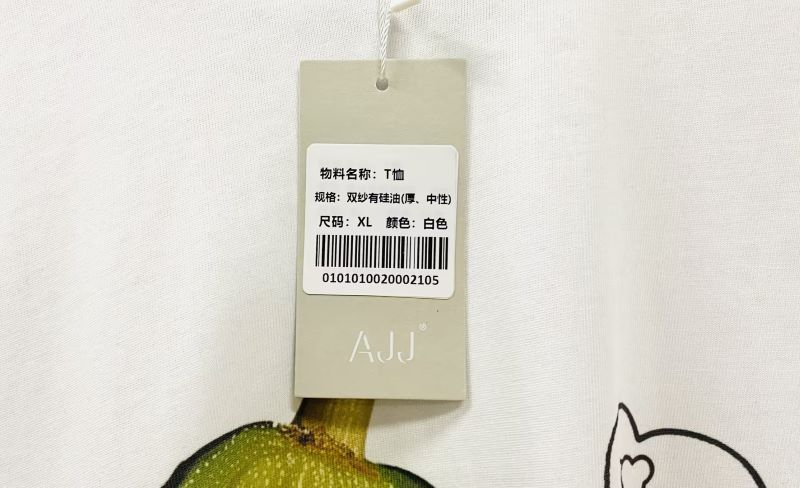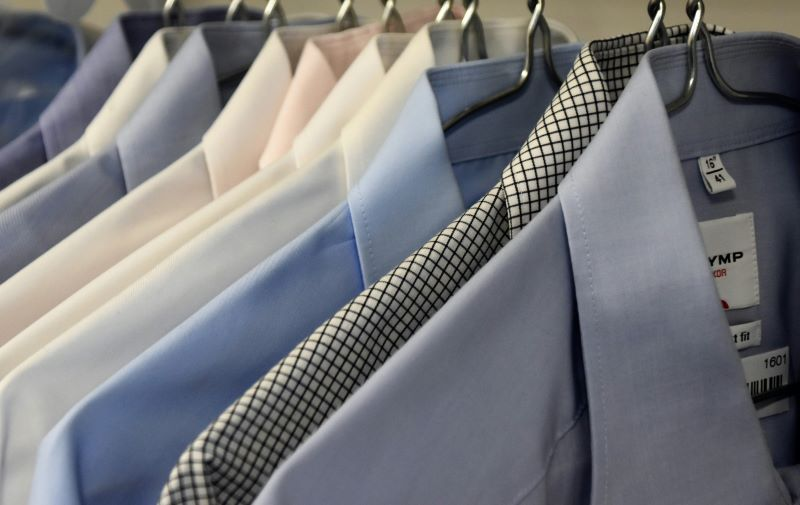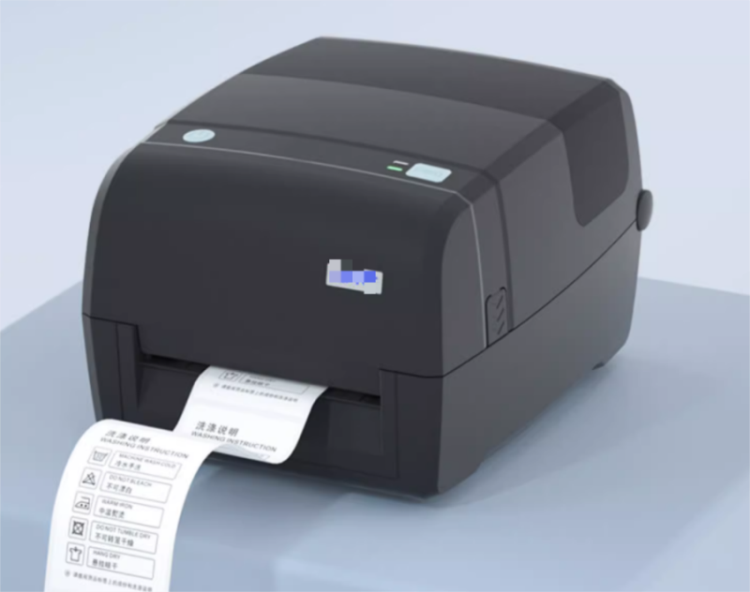
What Are Garment Barcodes?
Garment barcodes are codes used to identify products in the clothing industry, and track products at every stage of the supply chain. You'll usually see them printed on clothing tags, care labels, or hang tags. These barcodes help retailers and manufacturers keep track of stock, speed up checkout, and keep logistics running smoothly.
So, what information is stored in a garment barcode?
Barcodes for clothes usually holds details like the brand, manufacturer ID, product ID, and sometimes attributes such as size, color, and price. By encoding this data, they keep information accurate and consistent throughout the supply chain.
What Are Garment Barcode Labels?
Garment barcode labels refer to the adhesive stickers applied to clothing tags or external packaging, as well as sewn-in labels and care labels on clothing.
As a unique identifier for clothing, garment barcodes are often designed along with other garment information and printed on these tags and labels.
Clothing barcode labels and tags come in different materials, such as:
● Thermal adhesive stickers, great for quick-use labels like price tags or short-term promos in stores.
● Coated paper adhesive, often used on hang tags and packaging where you want a smooth, clean print.
● Polyester or high-quality Taffeta, tough enough for care labels and tags that need to survive washing.
● Satin, usually picked for premium clothing labels that look soft and high-end while still carrying a barcode.

When printing these barcode labels, it is essential to ensure that the text is clear and the barcode is readable.
How Do Garment Barcodes Work?
A garment barcode works like a product's digital ID. Product details are encoded into a visual pattern — this could be a set of lines, numbers, or even a two-dimensional symbol.
When scanned with a garment barcode scanner, the info goes straight into the database or inventory management system, so everything is updated instantly.
For example:
● In retail, a barcode scan updates stock levels in real time.
● In warehouses, barcodes speed up sorting, picking, and shipping processes.
● For customers, scanning a dress barcode or clothing tag at checkout ensures accurate pricing.
Types of Garment Barcodes in Clothing and Apparel
Different barcode types are widely used across the garment and fashion supply chain:
● UPC (Universal Product Code)
The most common barcode in the US retail industry. The typical version, UPC-A, uses 12 digits. Stores use them to scan items quickly at checkout and keep inventory up to date.
● EAN (European Article Number)
EAN is similar to UPC but is primarily used in Europe. It comes in 13 digits and is employed for international trade, making it easier to track products globally. Like UPC, it is usually printed on clothing hang tags or garment barcode labels.
● Code 128
Code 128 packs a lot of data into a small space. Since it supports both letters and numbers, clothing brands often use it as a garment barcode to encode details such as batch numbers, sizes, and manufacturing dates.
● QR Codes (Quick Response Codes)
QR codes store far more information than regular barcodes. In the garment industry, brands often use them for marketing — shoppers can scan a tag to see brand stories, care tips, or special offers right on their phone.
● Custom / Manual Barcodes
Smaller businesses often create their own barcodes with online barcode generator tools. These custom garment barcodes are simple to set up and give clothing brands a budget-friendly way to label and track their products.
RFID vs Garment Barcode: Which Is Better for Clothing Inventory?
Both RFID and barcodes help track garments, but they solve problems in different ways.
● Garment Barcodes: Cost-effective, easy to print and scan, and compatible with almost any POS or warehouse system.
● RFID Tags: Store more data, allow bulk scanning without line of sight, and give real-time stock updates. and are ideal for high-volume warehouses. Big retailers use them too: Zara cuts inventory checks to minutes, while Uniqlo builds RFID into price tags that also work as anti-theft.
Which One Should You Choose?
● If you're a growing clothing retailer or manufacturer that needs a cost-effective, simple, and universal solution, garment barcodes are still the best option.
● If you operate at global scale, handle high-volume warehouses, or want real-time tracking with fewer manual scans, RFID can deliver a stronger return on investment.
Benefits of Using Garment Barcodes
For small to mid-sized retailers, adopting barcodes for clothing brings three big advantages:
● Improved Customer Experience: Shoppers don't like waiting — staff can use a garment barcode scanner to read clothing tags or labels in a split second, which cuts checkout time and reduces pricing errors.
● Efficient Inventory Management: From factory to store shelf, barcodes keep product counts accurate and reduce stock discrepancies.
● Traceability
If a customer complains about a faulty item, you can trace it back to the production batch instantly.
Best Practices for Garment Barcode Labeling and Printing
Clothing manufacturers and retailers must follow garment barcode regulations and compliance when creating, printing, and placing barcodes on products. To ensure you get high-quality clothing barcodes, follow these best practices:
1. Generating Compliant and Professional Garment Barcodes
Use reliable barcode generators and software that adhere to industry standards. Ensure barcode files are high-resolution, correctly formatted, undistorted, and have sufficient contrast.
2. Printing High-Quality Garment Barcodes
Choose the right printer based on the label material:
● For fabric tags and satin care labels with garment barcodes, use a thermal transfer label printer with a rotary cutter for efficient printing and precise cutting.

Recommended model: HPRT Prime Fabric Label Printer
● For barcode stickers on hang tags and packages, a direct thermal label printer is a quick and cost-effective choice. However, if you need the barcodes to be more durable and scratch-resistant, consider a thermal transfer printer with suitable ribbon supplies.
Additionally, when printing small-sized barcodes, choose a 300dpi thermal label printer. Ensure barcode clothing labels are placed on flat, non-wrinkled areas — like hang tags or outer packaging — so scanners can read them quickly in retail and logistics.
3.Selecting the Right Garment Barcode Scanners
Pick a handheld barcode scanner with high accuracy and fast response time. Make sure it can read the barcodes common in clothing — UPC, EAN, Code 128, and QR codes for product details or marketing.
Garment Barcode FAQs
1.What type of barcode is used for clothing?
The most common barcode types in clothing are UPC (in the US) and EAN (international). Some brands also use Code 128 for internal tracking and QR codes for marketing.
2.Are garment barcodes washable?
Not always — washability depends on the material. Polyester, taffeta, or satin care labels can survive washing, but paper or sticker labels usually cannot.
3.How to scan a barcode of clothes?
You can scan clothing barcodes with a handheld barcode scanner connected to a POS system, or even with a smartphone camera if it supports 1D/2D barcode scanning.
4.Do dry cleaners put barcodes on clothes?
Yes. Many dry cleaners use small barcode tags or stickers to identify each garment, track the cleaning process, and ensure items are returned to the right customer.
5.Can garment barcodes be customized with a brand's design or logo?
Yes, barcodes can be printed alongside logos, care instructions, or brand designs on labels or hang tags, as long as the barcode area stays clear and scannable.
Garment barcodes are a simple, cost-effective tool for clothing brands to manage stock and speed up checkout. Implementing a garment tracking system with barcodes improves supply chain visibility, cuts errors, and simplifies product traceability from factory to store.
Start generating your barcodes today using our free barcode generator and experience the benefits firsthand.





